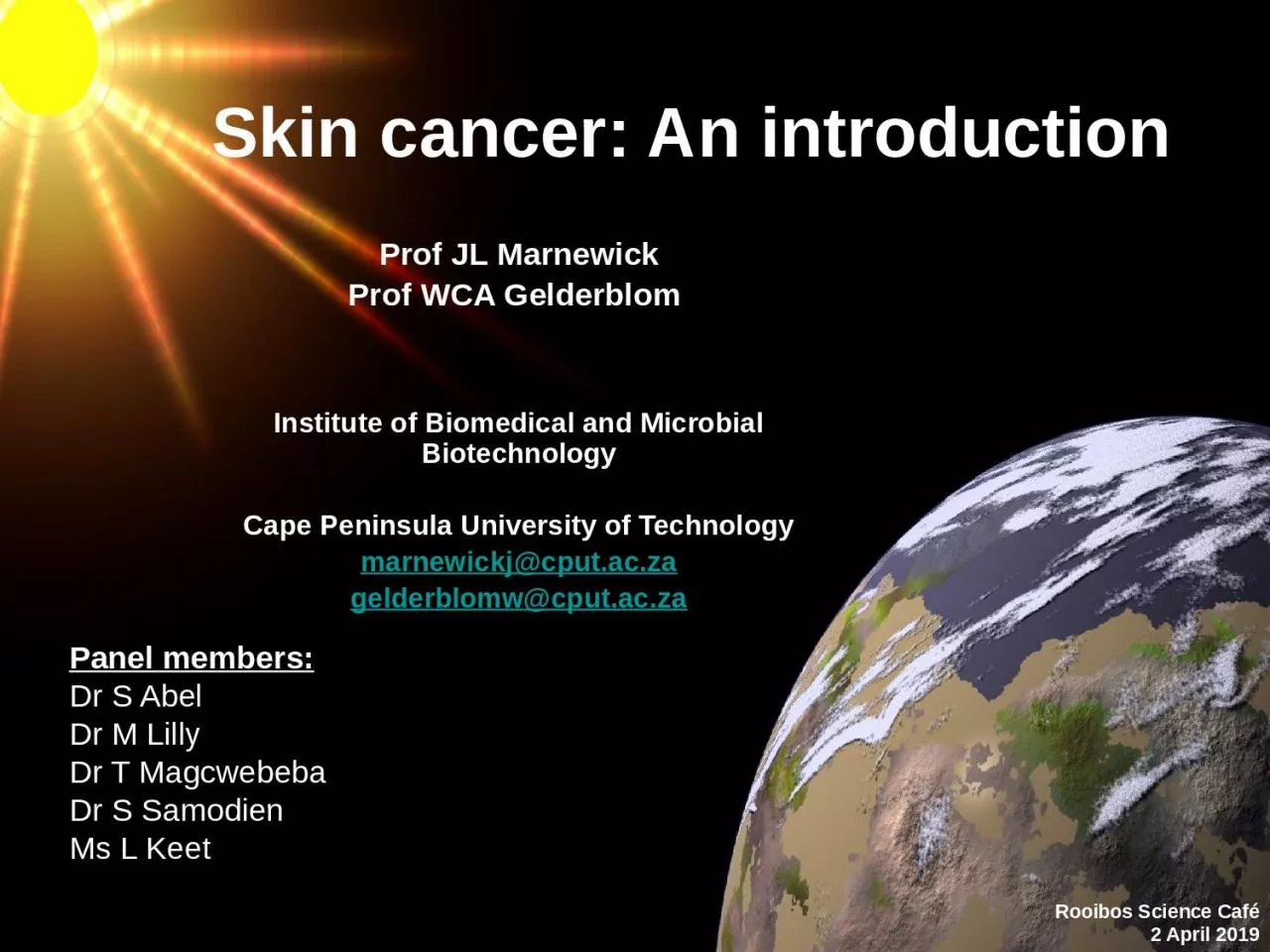

Prof JL Marnewick Prof WCA Gelderblom Institute of Biomedical and Microbial Biotechnology Cape Peninsula University of Technology marnewickjcputacza gelderblomwcputacza Rooibos Science Café ID: 1041359
Download Presentation The PPT/PDF document "Skin cancer: An introduction" is the property of its rightful owner. Permission is granted to download and print the materials on this web site for personal, non-commercial use only, and to display it on your personal computer provided you do not modify the materials and that you retain all copyright notices contained in the materials. By downloading content from our website, you accept the terms of this agreement.
1. Skin cancer: An introductionProf JL MarnewickProf WCA Gelderblom Institute of Biomedical and Microbial BiotechnologyCape Peninsula University of Technologymarnewickj@cput.ac.zagelderblomw@cput.ac.za Rooibos Science Café2 April 2019Panel members:Dr S AbelDr M LillyDr T MagcwebebaDr S SamodienMs L Keet
2. SKIN Skin largest organ 1.5-2 m2 Adult: ~3.6 kg of skin Different layers of the skin: Epidermis - Top/outer layer- Make new skin cells every month- Protecting the body (has immune cells) Dermis - Deeper layer- Making sweat to keep you cool- Help feel things (nerve endings)- Growing hair- Making oil- Bringing blood to the skin Fat layer - Attached dermis to muscles & bones - Help blood vessels & nerve cells - Control body temperature - Protects you from bumps & fallsINTRODUCTIONThe skin is our first line of defense!
3. SUNUltraviolet (UV) rays damage skin: UVA; UVBUVA: known as the “aging rays” it penetrates deeper skin layers, cause ageing, increased risk for cancer dominant ray used in tanning salonsUVB: known as the “tanning rays”, cause sever damage to the epidermis redness, cancer- causingUVC: most dangerous, BUT completely filtered out by the ozone layerINTRODUCTION
4. Adverse effects of chronic exposure to the sunInduce oxidative stressDNA damagePremature ageingEffects immune systemSkin diseaseMelanoma skin cancerNon-melanoma cancer, e.g. SCC (connected to tanning beds)Skin cancer STATSMost common cancer in SAEveryone is at riskWHO predicts increase in skin cancer as the ozone levels decrease20 000 reported cases annually, 700 deaths2nd highest incidence SA, Australia has highest incidenceINTRODUCTION
5. Current prevention strategies: (also refer to recommendations by CANSA):Avoid sun exposure between 10am to 3pmStay in the shade/under the umbrellaRemember: UV reflects off cement/water/sand/grass – you can still burnApply and re-apply your sunscreen oftenWe can’t change the environment, but we can change our attitude towards the sun, by taking an additional prevention approach, that of Photo chemoprevention: a strategy in which the occurrence of skin cancer is reduced by using naturally occurring or synthetic compoundsUse of to prevent or slow down the development of certain cancers is gaining popularity Plant components/polyphenol propertiesAnti-inflammatoryImmune modulatoryRedox modulation/Antioxidant Popular compounds to explore Rooibos and honeybush rich in polyphenolsINTRODUCTION
6. Interesting facts:The International Agency for Research on Cancer (IARC) in France has classified UV-emitting tanning devices (such as sunbeds “carcinogenic to humans” and classified it as a class 1 carcinogen (2009)Australia has banned the use of sun beds in certain states of their country since the 1st of January 2015The Cancer Association of South Africa (CANSA) has made a request to the Minister of Health to ban the use of sunbeds at least by our youth (<18yrs of age)INTRODUCTION
7. Most skin cancers found at an early stage can be treated successfully.Treatment depends on the type of skin cancer and the stage of the disease. Common Treatment for Skin Cancer: • Surgery • Various chemotherapies • Radiation • Biological drug treatments Other Possible Treatment: • Immunotherapy (for melanoma skin cancer) • Photodynamic therapy (for non-melanoma skin cancer)In 2015 alone, skin cancer cost the South African health system more than R90 million (more than US$6 million) - BMC Health Services Research Journal.INTRODUCTIONTreatment/Costs
8. Fig. 1. The cellular composition of the skin. Keratinocytes are a major source of IL-1. When activated and secreted, the cytokine induces an inflammatory response through activation and recruitment of immune cells (inspired from Nestle et al., 2009a).
9.
10. Panel discussionPanel members:Prof Wentzel Gelderblom (Chair - CPUT)Prof Jeanine Marnewick (CPUT) – co-chairDr Stefan Abel (CPUT)Dr Mariska Lilly (CPUT)Dr Tandeka Magcwebeba (US - post doc)Dr Sedicka Samodien (CPUT – post doc)Ms L Keet (US - PhD candidate) Skin Cancer Chemoprevention South African Herbal Teas
11. RooibosInflammationFree radicals (oxidative stress)Cell growthRooibos against cancer development in skinRemoves inflamed and damaged precancerous cells via programmed cell death
12.
13. ReferencesReferences and information sheetsSkin Cancer Fact Sheet (Prevention and Cancer Foundation)Fact Sheet – Skin Cancer 2010 (CANSA)Major findings: rooibos protects against adverse effects of UVB exposure. SARC media release; December 2016 (Prof WCA Gelderblom)SA children more at risk from sunburn at school due to inadequate sun protection policies. SARC media release; January 2017 (Dr T Magcwebeba)